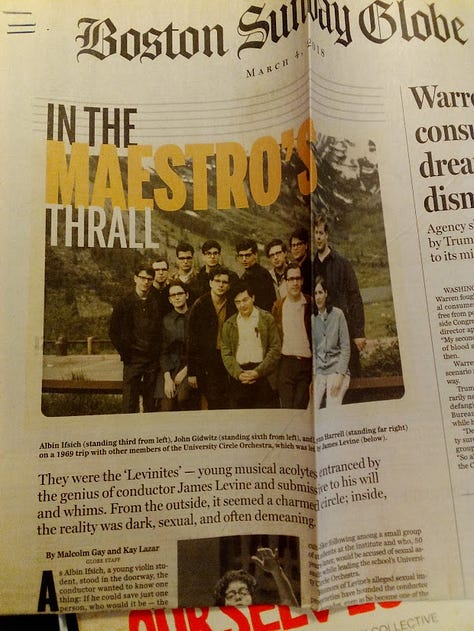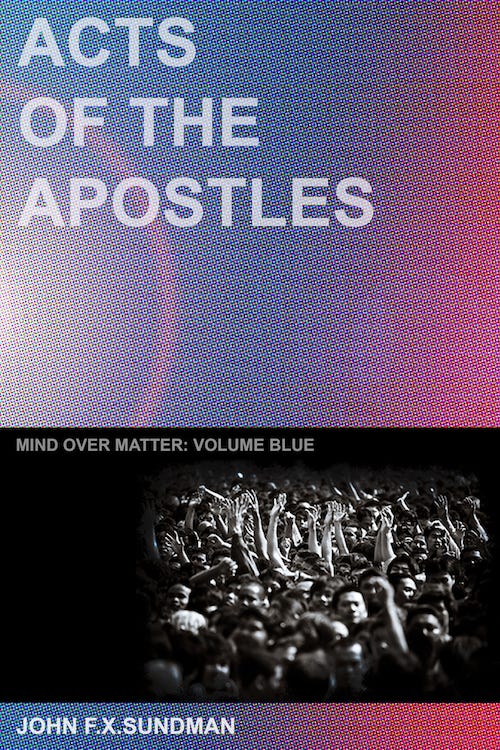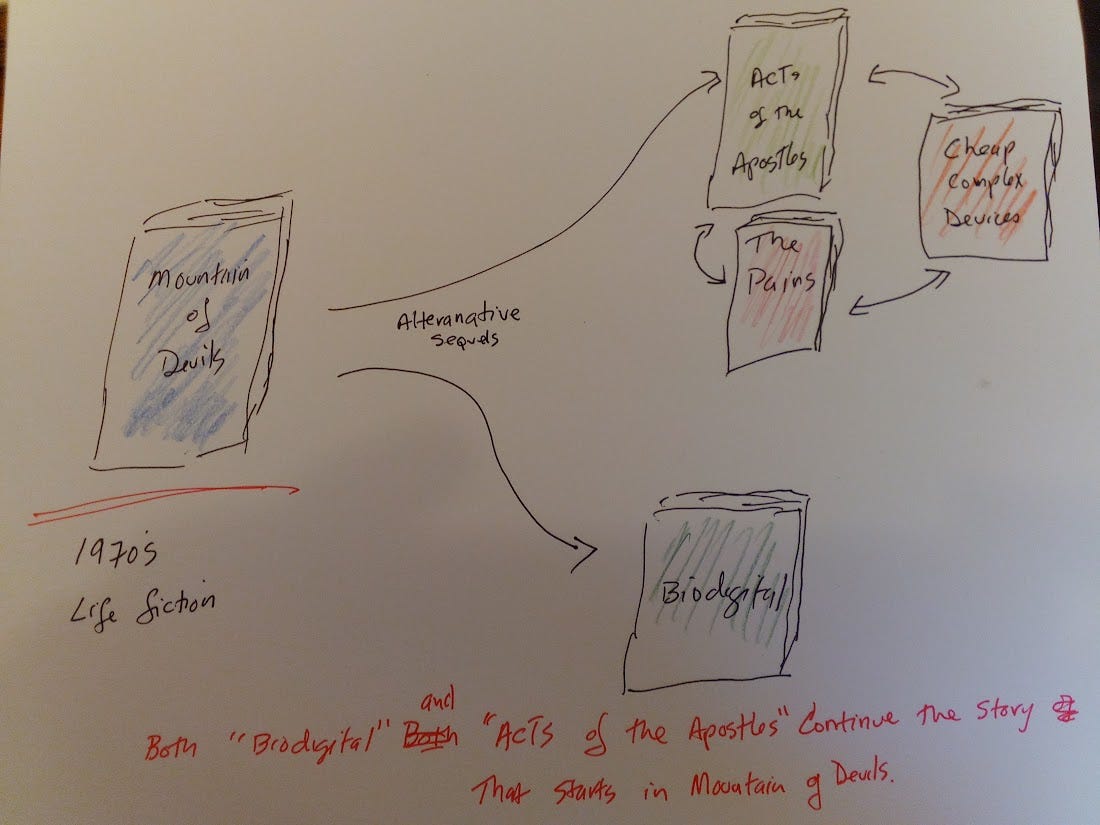Mountain of Devils and Creation Science
A peak at 2 novels in progress, part one
Précis
This 2-post essay is about technique, about my process as a novelist and how I’ve approached certain challenges. I’ll show some of my sketches and and notes and research materials, and I’ll discuss some problems that I’ve solved as well as some that I’m still puzzling over.
I know that some readers of Sundman figures it out! have read all of my books assiduously, that others have read none of them, and the rest of you are somewhere in between. This post is for everyone, whether you’ve read any of my books or not, according to how much the subject of writing novels interests you.
Two novels coming Real Soon Now
I’m working on two novels: Mountain of Devils and Creation Science. Since I’ve promised Mountain of Devils (“MoD”) for this October and I haven’t finished writing it yet it’s getting most of my attention.
The original target date for was in 2010, so I’m running a bit behind. Thirteen years and counting. I’d love to finish a first draft before 2024 but completing Mountain of Devils and republishing my four other existing books with new new introductions are much higher priority. But I do put in a few hours on Creation Science every now and then.
Mountain of Devils and its sequels
Mountain of Devils is the prequel to both Acts of the Apostles and Biodigital. Acts and Biodigital are set in the 1990’s; MoD takes place in the 1970s.
These books share several characters. In particular, three of the characters that we meet as adults in Acts and Biodigital are teenagers in MoD. Although several of the characters in MoD are young people, it is not intended to be a “YA” book.
Just as you can read Lord of the Rings before you read The Hobbit, or the other way around, Mountain of Devils and its alternate sequels can be read in either order. But in order to explain how I’m approaching challenge of writing Mountain of Devils, I find it useful to discuss those other books first.
Acts of the Apostles, where it all began
Acts, which I self-published in late 1999 after endless revisions, is the story of the Silicon Valley evil genius Monty Meekman and the cult of techbros who venerate him, and of their dastardly plan for world domination, and of the plucky band of misfits, led by bunt-out software engineer Nick Aubrey, who attempt to thwart them.
Pantsing all the way
In discussions of novelistic technique, one sometimes sees a distinction made between ‘pantsing’ (writing by the seat of your pants, with only a general notion of where you’re going) and ‘plotting’ (completing a detailed outline before writing the text). When I wrote Acts of the Apostles, I was pantsing all the way.
When I began working on the book, my first-ever attempt at a novel, my plan was to write a simple mystery: Todd, a computer engineer in Massachusetts, discovers a trojan horse embedded in the circuitry of the chip he has been designing. Hours after phoning his boss in California to tell him what he has found, Todd gets shot in the head. So, who shot him, and why? Pretty straightforward, right?
I had a mental model of the villain, and I knew who the protagonist was going to be (Nick Aubrey, a bi-coastal software engineer whose his career is circling the drain), and I had a vivid image Nick’s friend Todd, the chip designer who gets shot very early on in the book. I also knew that Nick’s five-year marriage to Bartlett, a molecular biologist doing research on a rare neurodegenerative disease, was strained. In fact, Bartlett had recently moved to her own apartment in Boston.
So with this vague map in mind, I began writing. And it went well for the first five or eight chapters. The words came fast. Until they stopped.
A hole in the plot rescues the book
One question kept nagging at me: Todd was shot after he discovered that a coworker had designed a trojan horse into the logic of the chip they were working on together. But why would anyone go to all the trouble of putting a trojan horse into the silicon circuitry of a computer chip when it is so much simpler to do it in software?
It was as if the bad guys, whoever they were, had devised an ingenious plan to break into somebody’s house by going down the chimney like Santa Claus when they already had the key to the front door. Why would they do that? It just didn’t make sense. I reached a point where I had to either figure out why someone had hidden a virtual CPU inside another CPU, or I had to give up on the book. I had written myself into a corner.
By the time I emerged from that corner, after four solid years of work, my book longer was no longer the simple mystery I had naively set out to write.
It was a thriller about hardware hacking and genetic engineering and mind control and brain-re-arranging nanobots and techno-paranoid cyber-militias and Gulf War Syndrome and what-all else. It was about a man who dreams of becoming God, and the cult of followers who try to make his dream a reality.
I put my book out into the world thinking I had written a nifty mystery about Gulf War Syndrome. But readers soon informed me that the book I had written wasn’t about that, it was about hacking. Acts of the Apostles, I was told, was pure cyberpunk. I had become a writer of science fiction without even knowing it.
Gradually Acts became, for a while, a hit. After a Slashdot review, I outsold Tom Clancy and Michael Crichton on Amazon. (OK, it was only for a weekend. But still.) Acts even won the Writer’s Digest National Self-published book award for the year 2000. Salon:
Acts of the Apostles" is a nanotech science-fiction thriller packed with everything you would expect a hardcore geek to like. Nanotechnology -- the design of molecule-sized machines -- may still be the stuff of future fantasy, but the references to software code, silicon chips and DNA that run through this novel reek of realness. It's just what you would hope for from an author who spent nine years working for Sun Microsystems: a book with geek heroes and heroines, written by a geek, and concerned with geek passions.
But it's also a book infused with a sensibility that you don't normally expect a "hard science fiction" novel to have: real emotions, real heartbreak and a real sense of the craziness at the core of the human condition.
Twenty three years later the book is still my best-known and most popular. Acts of the Apostles is not a perfect book, but uber-geek and SF novelist Cory Doctorow is writing the introduction to the forthcoming reissue. I think that attests to its status as a hacker-geek cult classic.
Dramatis Personae
Among the significant characters in Acts of the Apostles (and Biodigital, q.v.) who also appear in Mountain of Devils:
Montaigne (“Monty”) Meekman, ~50, once known as Abraham Angevine, an evil-genius polymath and the richest and most powerful man in Silicon Valley (although few understand just how rich, powerful, smart or evil he really is);
Nick Aubrey, mid-thirties, a burnt out software engineer whose career is on the skids;
Bartlett (McGovern) Aubrey, early thirties, Nick’s estranged wife, a molecular biologist with a research laboratory in downtown Boston;
Pavel Issacs, mid-thirties, once known as Jamal Jackson, a brilliant computer and biomolecular engineer fanatically devoted to Meekman;
Although the central conflict in Acts of the Apostles is between Nick and Monty, we learn, almost in passing, late in the book, that years before Nick met Meekman, Bartlett herself had had brief but fateful encounter with him. Nick is unaware of this.
Biodigital — Acts of the Apostles, reimagined
In 2011 Underland Press, a tiny publishing house with an outsize reputation for high quality scary/creepy books, offered me a contract to publish a new edition of it — contingent upon my making some ‘minor revisions’ under Victoria Blake’s editorial guidance (Blake pretty much was Underland). I cashed my $1,000 advance check figuring I had a few week’s worth of work ahead of me.
One year later, about 40% of the original Acts was gone, replaced by an equal amount of new stuff. Thoroughly reimagining this book was hard work and not fun. I did it because I believed that being published by Underland would confer some kind of validation on my works that I couldn’t hope for as a self-publishing novelist.
Just when the work was finally done to Blake’s satisfaction she told me that she had sold Underland to another publisher, and that the new owner wasn’t picking up the rights to Acts. The rights then reverted to me. Oy.
So called this new version Biodigital, and published it myself.

Biodigital: A different pre-history for Monty & Bartlett
In Acts of the Apostles, Bartlett’s earlier history with Monty Meekman is a curious footnote, the subject of a few paragraphs. It happened when Bartlett was an adult. It’s no big deal.
In Biodigital, however, we get strong hints that whatever went on between Bartlett and Monty (or Abraham Angevine, as he was then known), back in the 1970’s, (and whatever went on in the past between Bartlett and Judith, and between Bartlett and Pavel/Jamal), it was not a small thing. Whatever it was — Biodigital only gives us hints — it was a big deal.
Mountain of Devils: Monty & Bartlett, front & center
Mountain of Devils is the story of how Bartlett McGovern left girlhood for science, how Abraham Angevine became Monty Meekman, and of the terrifying intersection of those two paths.
I first began toying with the ideas for this book more than a dozen years ago. My original idea was to write a 40-page story that I could give away to induce readers to buy a copy of either Acts or Biodigital. I figured I would write about the Young Pioneers of Science conference high in the remote mountains of California mentioned briefly in Biodigital, where Bartlett, Judith, Pavel Isaacs and Monty Meekman had had some kind of fateful encounter.
As I wrote, the story began to grow. I next thought it would be a novella, and I came up with a name for it: Meekman Rising. Its main subject was the transformation of the egotistical young Stanford computer science professor Abraham Angevine into the world-class supervillain Monty Meekman.
Over time the story I was writing grew into much more than that. Angevine’s transformation into Meekman happened within a particular cultural context, and I wanted to capture that. I wanted to make my readers experience the parallel revolutions going on in molecular biology in the 1970’s an in the world of phone phreaks and computer hackers. I wanted my characters buffeted on all sides by aftereffects of the War in Vietnam and the antiwar counterculture and the Black Panther movement and the backlash against it mixed confusedly to the contrasting soundtracks of McCoy Tyner, Jimmy Webb and Led Zeppelin. I wanted to dress Monty Meekman in a leisure suit and make your cringe at the thought of it.
But more importantly I became obsessed with understanding not only how Angevine became Meekman and how he manipulated people into believing that he was some kind of deity, but how he sunk his psychological fangs into two young people in particular: Bartlett McGovern and Jamal Jackson. I needed to understand how Bartlett grew up so fast, and how the mysterious character Pavel Isaacs emerged from Jackson like a butterfly from a caterpillar.
These were not questions that could be answered in a 40-page story. I changed the name of Meekman Rising to Mountain of Devils.
Research
I asked the principal of Tisbury School to introduce me to some 6th grade kids to be my story consultants & met with them in his office. I read Antonia White’s Frost in May, an exquisite novel about a nine year old girl who grows into a 14 year old woman. I bought ancient science textbooks and Playboy and Tiger Beat magazines.






I interviewed Nobel Laureate Paul Berg about the Asilomar Conference on Recombinant DNA, and an old girlfriend of mine who happened to have been working as a maid at the the Asilomar Conference Center when that legendary conference happened. I read articles and books on cults and charismatic leaders and narcissists and self-anointed messiahs. I listened to 70’s music, from jazz to rock to schlock. I read Frost in May again. I bought a copy of the 70’s feminist classic Our Bodies Ourselves, and Mary William’s The Lost Daughter, about growing up poor in the Black Panther movement in Oakland and somehow ending up Jane Fonda’s adopted daughter. I read about phone phreaks. I read Frost in May a third time.
The Mind over Matter conundrum
In Acts of the Apostles, the character Todd gets shot in the head early on. But he doesn’t die. He lives on in a permanent vegetative state, and this fact provides the gateway to my two novellas, Cheap Complex Devices and The Pains. I call the metafictiony trilogy of Acts/CCD/Pains ‘Mind over Matter.’
But in Biodigital, Todd just gets killed.
Mountain of Devils dovetails much more smoothly with Biodigital that it does with Acts of the Apostles, but Biodigital is my least well known book. Acts has outsold Biodigital about 40 to 1.
So what’s the best way for me to market Mountain of Devils? Is it the prequel to Acts of the Apostles or to Biodigital? The answer is ‘both’, of course. It doesn’t matter.
I just hope you’ll check it out when I publish it next fall.
Two Book Promos for you
Sign up for an author’s mailing list, get a free book. Both of the below promos feature my illustrated dystopian phantasmagoria The Pains. Every click on either of these images helps me, whether or not you claim a book from me or anyone else.








Great background, looking forward to the new one.
Clarification: original publication date for *Creation Science* was 2010.